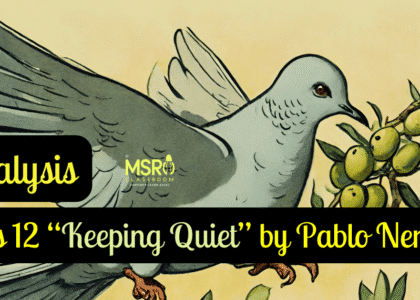Poem 1, Kamala Das’ ‘My Mother at Sixty-Six’ Summary, Theme, Line-by-Line Explanation, Poetic Devices, Analysis, Question Answers with Extract-Based Questions.
Poem 1- My Mother At Sixty-Six by Kamala Das:
Kamala Das
Kamala Das (1934-2009), also known as Kamala Suraiyya, was a prominent Indian poet and writer. She fearlessly explored themes of love, sexuality, and identity in her works, challenging societal norms.
‘My Mother At Sixty-Six’ is from the collection ‘Best of Kamala Das‘ publisged in 1991.

Table of Contents
Next on Flamingo: Poem 2-‘Keeping Quiet‘ Pablo Neruda, Poem 3-‘A Thing of Beauty‘ John Keats
Supplementary Reader: Class 12 ‘Vistas‘
Vocabulary:
| Ashen: Pale or grey, linked to death or illness. Corpse: A dead human body. Doze: To sleep lightly; nap. Merry: Cheerful and lively. Open-mouthed: Mouth open, often from surprise or fatigue. Pale: Light in colour; lacking brightness. Spilling: Pouring out in large quantities. Sprinting: Running quickly over a short distance. Yards: Units of length. Wan: Pale or sickly appearance; lacking vitality. |
Summary ‘My Mother at Sixty-Six’:
In “My Mother at Sixty-Six,” Kamala Das takes readers on a journey where she confronts the stark reality of her mother’s ageing during a drive to the airport. Witnessing her mother’s frailty, symbolised by her ashen face, triggers a wave of emotions – from denial to fear and eventually resignation. Despite the vibrant scenes outside the car window, the poet’s attention is drawn to the inevitable passage of time and the fragility of life.
Das captures the universal experience of coming to terms with a loved one’s mortality through simple yet profound imagery. The poem serves as a poignant reminder of the transient nature of existence and the enduring bond between parent and child.
Central Idea: My Mother at Sixty-Six:
In Kamala Das’ poem “My Mother at Sixty-Six,” the poet shares her emotions as she drives her mother to the airport. The poem captures the feelings of coming to terms with a parent’s ageing, the fear of loss and the attempt to hide these emotions with a smile. The poet observes her mother as she sleeps with an open mouth and sees her as a reflection of mortality. Despite the vibrant scenes outside, the poet feels the stark contrast of her mother’s frailty. “My Mother at Sixty-Six” reflects on the inevitable passage of time and the complexities of the parent-child relationship.
Analysis and Explanation of ‘My Mother at Sixty-Six’ for Auditory Leaners:
Duration: 12 Minutes
Chapters/time stamps with English subtitles are available.
Line-by-Line Explanation ‘My Mother at Sixty-Six’:
1. “Driving from my parent’s”
The poem starts with the speaker, presumably Kamala Das herself, driving from her parents’ home.
2. “home to Cochin last Friday”
The speaker travels from her parent’s home to Cochin on a Friday morning.
3. “morning, I saw my mother,”
4. “beside me,”
During the journey, the speaker observes her mother, who accompanies her. The mother is sitting beside the speaker in the car.
5. “doze, open mouthed, her face”
The mother is dozing off with her mouth open, showing signs of old age.
6. “ashen like that”
Her face appears pale and lifeless.
7. “of a corpse and realised with pain”
The speaker realises with sadness that her mother’s appearance reflects her age and frailty.
8. “that she was as old as she looked”
The speaker accepts that her mother’s appearance accurately represents her age.
9. “but soon put that thought away”
The speaker tries to suppress the thought of her mother’s ageing, possibly to avoid confronting the emotions it brings.
10. “and looked out at Young Trees sprinting,”
The speaker shifts her attention to the young trees passing by, contrasting her mother’s ageing.
11. “the merry children spilling out of their homes,”
The sight of cheerful children adds to the contrasting emotions, emphasising the cycle of life.
12. “but after the airport’s security check,”
The poem shifts to a different location, the airport, where the speaker and her mother are separated due to security protocols.
13. “standing a few yards away,”
The speaker is standing a few yards away from her mother after the security check.
14. “I looked again at her, wan, pale”
The speaker looks at her mother again and notices her paleness and weariness.
15. “as a late winter’s moon”
The comparison to a late winter’s moon suggests her mother’s fading vitality.
16. “and felt that old familiar ache, my childhood’s fear,”
The speaker experiences a familiar pain and fear reminiscent of her childhood when she might have feared her mother’s mortality.
17. “but all I said was, see you soon, Amma,”
Despite her emotions, the speaker tries to remain composed and casually bids farewell to her mother using the endearing term “Amma” (Mother).
18. “all I did was smile and smile and smile……”
The poem ends with repetition, emphasising the speaker’s efforts to mask her emotions with a smile, even though she feels a mix of sadness and love for her ageing mother.
Question Answers “My Mother at Sixty-Six”:
Textbook Question Answers:
Q1: What is the kind of pain and ache that the poet feels?
A1: The pain and ache the poet feels are twofold. First, she acknowledges her mother’s ageing, seeing her as frail and mortal, which evokes a sense of sorrow and fear of loss. Second, nostalgia and childhood memories ache her, reminding her of the passage of time and the shifting dynamics of their relationship.
Q2: Why are the young trees described as ‘sprinting’?
A2: The young trees are described as ‘sprinting’ to convey a sense of vitality and energy. This description juxtaposes the image of the poet’s ageing mother, highlighting the stark contrast between the vigour of youth and the frailty of old age.
Q3: Why has the poet brought in the image of the merry children ‘spilling out of their homes’?
A3: The image of the merry children ‘spilling out of their homes’ contrasts the poet’s mother’s condition. It symbolises youth’s vibrancy and exuberance, emphasising life’s cyclical nature and the inevitability of change.
Q4: Why has the mother been compared to the ‘late winter’s moon’?
A4: Comparing the mother to the ‘late winter’s moon’ evokes a sense of pale, distant beauty tinged with melancholy. Like the moon in late winter, her mother appears wan and pale, reflecting the passing of time and the fleeting nature of life.
Q5: What do the parting words of the poet and her smile signify?
A5: The parting words of the poet, “see you soon, Amma,” and her persistent smile despite her inner turmoil signify her attempt to mask her emotions and maintain a facade of normalcy. It reflects the universal experience of hiding one’s pain and sorrow behind a smile, especially when faced with the inevitability of separation and the passage of time.
Extract Based Questions ‘My Mother at Sixty-Six‘
Extract 1:
“Driving from my parent’s
home to Cochin last Friday
morning, I saw my mother,
beside me,
doze, open mouthed, her face
ashen like that
of a corpse and realised with pain
that she was as old as she
looked but soon
put that thought away,”
Q1: What does the speaker notice about her mother while driving to Cochin?
A1: The speaker notices her mother dozing with her mouth open, and her face looks pale, like a corpse’s. The speaker realises that her mother’s appearance reflects her actual age.
Q2: How does the speaker react to the realisation of her mother’s age during the drive?
A2: The speaker initially feels pain realising her mother’s actual age but decides to dismiss that thought and focuses on the passing scenery.
Extract 2:
“looked out at Young
Trees sprinting, the merry children spilling
out of their homes, but after the airport’s
security check, standing a few yards
away, I looked again at her, wan, pale
as a late winter’s moon and felt that old
familiar ache, my childhood’s fear,”
Q1: What does the speaker observe outside the car during the drive?
A2: The speaker sees young trees moving quickly and cheerful children playing outside their homes.
Q2: How does the speaker’s perception of her mother change after the security check at the airport?
A2: After the security check, the speaker looks at her mother again and notices her looking pale and weak, reminiscent of a pale winter’s moon. This sight triggers a sense of familiarity and sadness in the speaker, reminding her of a fear she experienced during childhood.
Extract 3:
“all I said was, see you soon, Amma,
all I did was smile and smile and
Smile……”
Q1: How does the speaker bid farewell to her mother before parting ways?
A2: The speaker simply says, “See you soon, Amma,” and responds with smiles, repeating the act of smiling.
Q2: What is the significance of the speaker’s repeated smiles in this context?
A2: The repeated smiles could suggest that the speaker is masking her inner sadness or concern with a cheerful facade, attempting to reassure her mother.







